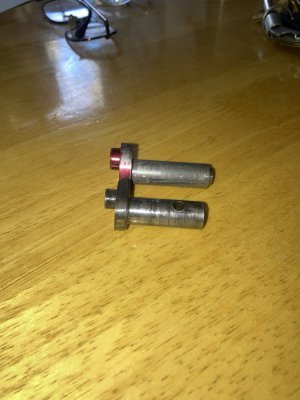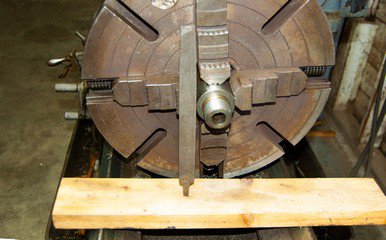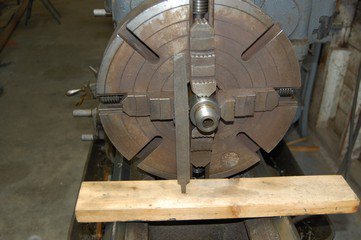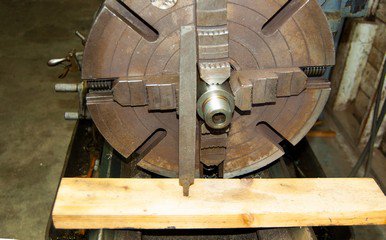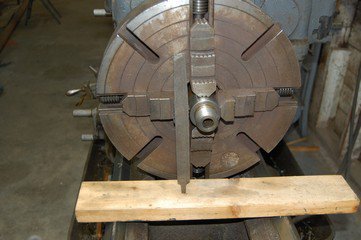Probably about 15-20 years ago, my Dad quit using power tools and gave them to me. These included a South Bend Model C lathe. Dad was a professional machinist and completely rebuilt this lathe, including hand scraping of the ways. Nice lathe, especially for a beginner (I had machine shop classes in High School but that was in the 1960s). The lathe came with a 3-jaw and a 4-jaw chuck, and a wheelbarrow load of machinist tools. The lathe was given to my Dad by a company that wanted him to make some small parts for them in his retirement.
I muddled around for a while with the lathe and made some small parts but a job change and a move in 2012 put a stop to machining for about 5 years. Everything sat unused. In 2017 I retired and started to get back into machining and bought a Precision Matthews PM-25MV bench-top milling machine. I started watching YouTube videos, and still do. I made a number of projects and have more in the works.
However, in all this time I have never used a 4-jaw chuck. I watched YouTube with presenters saying tighten the highs and loosen the lows, while spinning a chuck by hand and showing an indicator needle spinning wildly about and me not being able to determine what was a high and what was a low. It was just a spinning needle on an indicator. I stuck with my 3-jaw chuck.
2-years ago I bought a PM-1236 lathe. Wow, what a difference from the small South Bend. The South Bend was severely under-powered and I could bring it to a stop with only about a .015" DOC in aluminum. This new lathe came with a lot of accessories and marveled at its capabilities. It had a 4-jaw chuck, which I promptly put in a drawer and left it there. It stayed there for almost 2-years, unused.
About 2-3 months ago I wanted to make a new machinist hammer. Easy, right? I decided to start with a main body the is square with each end tapering down to a round end to match the striking surfaces of the hammer (ala Artisan Makes, on YouTube). To mount the square stock I needed the 4-jaw chuck. Thus, after owning this chuck for almost 2 years, I finally broke into the box, cleaned up the chuck (still covered in the original packing oil), and put it on the lathe. After watching more videos I thought that I had a handle on highs and lows and could make this work. I opened the jaws to about 1"opening and tightened it back down, loosely. From there it turned out really bad. One jaw eventually was out more than 1/4" from where I started. I would set one jaw to 0 on the indicator, flip to the opposing jaw and see a reading but not know if the reading was a high or a low. I couldn't follow the spinning needle because it wasn't spinning. I had to hold the indicator off the square part to keep it being damaged by the square corners. When I released the indicator stem there was a reading but It was simply a reading. I couldn't tell if it was high or low. After about 30 minutes I decided to take another route.
I planned to turn the part between centers. However, it turns out that none of my lathe dogs would hold the 1" square material. I was now thinking about switching to a round head. It then dawned on me to go to the milling machine and center drill each end of the part. Going back to the lathe I mounted it between centers, then closed each jaw of the 4-jaw chuck against the part to hold it.
I turned the taper on each end.
I took out the part, removed the 4-jaw chuck and put it back in the drawer, perhaps never to be seen again. That is, unless I need to turn another square part between centers.
I feel like a freaking idiot with my foray into using a 4-jaw chuck. Are square parts harder to center up than round parts or am I simply that idiot that I mentioned? Since I've gotten along for sometime now without a 4-jaw chuck, is it even necessary to figure this out? Anybody else out there just give up on the 4-jaw?
Thanks,
Denny
I muddled around for a while with the lathe and made some small parts but a job change and a move in 2012 put a stop to machining for about 5 years. Everything sat unused. In 2017 I retired and started to get back into machining and bought a Precision Matthews PM-25MV bench-top milling machine. I started watching YouTube videos, and still do. I made a number of projects and have more in the works.
However, in all this time I have never used a 4-jaw chuck. I watched YouTube with presenters saying tighten the highs and loosen the lows, while spinning a chuck by hand and showing an indicator needle spinning wildly about and me not being able to determine what was a high and what was a low. It was just a spinning needle on an indicator. I stuck with my 3-jaw chuck.
2-years ago I bought a PM-1236 lathe. Wow, what a difference from the small South Bend. The South Bend was severely under-powered and I could bring it to a stop with only about a .015" DOC in aluminum. This new lathe came with a lot of accessories and marveled at its capabilities. It had a 4-jaw chuck, which I promptly put in a drawer and left it there. It stayed there for almost 2-years, unused.
About 2-3 months ago I wanted to make a new machinist hammer. Easy, right? I decided to start with a main body the is square with each end tapering down to a round end to match the striking surfaces of the hammer (ala Artisan Makes, on YouTube). To mount the square stock I needed the 4-jaw chuck. Thus, after owning this chuck for almost 2 years, I finally broke into the box, cleaned up the chuck (still covered in the original packing oil), and put it on the lathe. After watching more videos I thought that I had a handle on highs and lows and could make this work. I opened the jaws to about 1"opening and tightened it back down, loosely. From there it turned out really bad. One jaw eventually was out more than 1/4" from where I started. I would set one jaw to 0 on the indicator, flip to the opposing jaw and see a reading but not know if the reading was a high or a low. I couldn't follow the spinning needle because it wasn't spinning. I had to hold the indicator off the square part to keep it being damaged by the square corners. When I released the indicator stem there was a reading but It was simply a reading. I couldn't tell if it was high or low. After about 30 minutes I decided to take another route.
I planned to turn the part between centers. However, it turns out that none of my lathe dogs would hold the 1" square material. I was now thinking about switching to a round head. It then dawned on me to go to the milling machine and center drill each end of the part. Going back to the lathe I mounted it between centers, then closed each jaw of the 4-jaw chuck against the part to hold it.
I turned the taper on each end.
I took out the part, removed the 4-jaw chuck and put it back in the drawer, perhaps never to be seen again. That is, unless I need to turn another square part between centers.
I feel like a freaking idiot with my foray into using a 4-jaw chuck. Are square parts harder to center up than round parts or am I simply that idiot that I mentioned? Since I've gotten along for sometime now without a 4-jaw chuck, is it even necessary to figure this out? Anybody else out there just give up on the 4-jaw?
Thanks,
Denny


